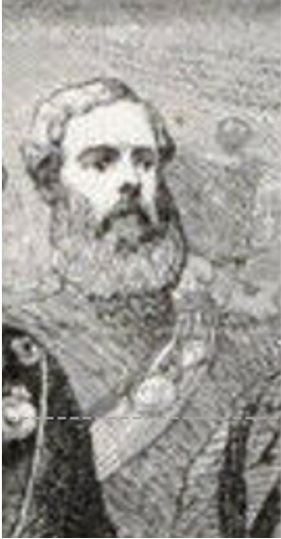
Detail from Illustrated London News Engraving
Captain Sir John Alexander Gavin Campbell, 6th Earl of Breadalbane and Holland was born on 30 March 1824 in London, the son of William John Lamb Campbell of Glenfalloch and Rosanna Doughty. He was the grandson of James Campbell, great-great-grandson of William Campbell of Glenfalloch (died 1648), brother of Colin Campbell of Mochaster. His seat was at Taymouth Castle.
He married Mary Theresa Edwards on 120 April 1853 and they had four children, Lady Eva Campbell, Sir Gavin Campbell, 7th Earl and 1st Marquess of Breadalbane and Captain the Hon Ivan Campbell and a fourth child who did not survive infantry, Norman Campbell.
He was an Ensign in the Victoria Rifles before joining the Royal Scots and rising to the rank of Captain. He is shown in the Illustrated London News Engraving published in April 1863, a detail of which is shown above.
He was an initiate of the Lodge of Unity, Peace, and Concord No 316 (then No 396), the Lodge associated with the Royal Scots.
He succeeded as the 10th Baronet Campbell, of Glenorchy, co. Perth November 1862. He succeeded as the 6th Viscount of Tay and Paintland on 8 November 1862. He succeeded as the 6th Earl of Breadalbane and Holland on 8 November 1862. He succeeded as the 6th Lord Glenurchy, Benederaloch, Ormelie and Weick on 8 November 1862.
He died on 20 March 1871 at age 46 in The Albany, Piccadilly, London, England. He was succeeded by his eldest son, who also joined the Lodge.
In 1872 his estate established his rights to the Breadalbane estates after one of the more famous Peerage succession cases in the United Kingdom.
The 6th Earl’s predecessor in the line of succession, the Marquess died without issue at Lausanne in 1862. The Earldom was claimed by Sir John Alexander Gavin Campbell of Glenfalloch, as great-great-grandson of William, fifth son of Sir Robert Campbell, third baronet of Glenorchy. There was, however, a question as to his legitimacy.
His grandfather, it appeared, a younger son of the Glenfalloch of his time, had, while an officer in the army, run away with the wife of an apothecary at Bath, and though the apothecary presently died, it was questioned whether a union so begun could afterwards be accepted as legitimated by a Scottish marriage and so legitimize the offspring of the union.
Glenfalloch’s claim to the Earldom was accordingly disputed by the representative of his grandfather’s younger brother, Campbell of Borland. In the end, however, it was shown that the gay young officer and the lady of Bath had been received at Glenfalloch by the young officer’s father and mother, who were strict in their religious views, and unlikely to have countenanced the lady unless they regarded her as really their son’s wife. The House of Lords accordingly decided in favour of Glenfalloch’s claim, and he became sixth Earl of Breadalbane.
His eldest son, Sir Gavin Campbell, the late head of the house, succeeded in 1871, held several high positions in the Royal Household. He was a Lord-in-Waiting from 1873 to 1874, Treasurer of the Household 1880-5, Lord Steward of the Household 1892-5, also ADC to the King and Lord High Commissioner to the General Assembly of the Church of Scotland in 1893-1895. He was created Baron Breadalbane in the peerage of the United Kingdom in 1873, and advanced to the Earldom of Ormelie and Marquessate of Breadalbane in 1885. He was also a Knight of the Garter and a Privy Councillor, and was Keeper of the Privy Seal of Scotland from 1907.